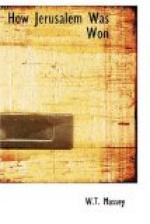By December 2 the fine exertions of the troops on the line of communications had enabled the XXth Corps Commander to make his plans for the capture of Jerusalem, and at a conference at Enab on the following day General Chetwode outlined his scheme, which, put in a nutshell, was to attack with the 60th and 74th Divisions in an easterly direction on the front Ain Karim-Beit Surik and, skirting the western suburbs of Jerusalem, to place these two divisions astride the Jerusalem-Nablus road, while the 53rd Division advanced from Hebron to threaten the enemy from the south and protect the right of the 60th Division. I will not apologise for dealing as fully as possible with the fighting about Jerusalem, because Jerusalem was one of the great victories of the war, and the care taken to observe the sanctity of the place will for all time stand out as one of the brightest examples of the honour of British arms. But before entering upon those details I will put in chronological sequence the course of the fighting on this front from the moment when the XXth Corps took over the command, and show how, despite enemy vigilance and many attacks, the preparations for the outstanding event of the campaign were carried through. It is remarkable that in the short period of ten days the plans could be worked out in detail and carried through to a triumphant issue, notwithstanding the bad weather and the almost overwhelming difficulties of supply. Only the whole-hearted co-operation of all ranks made it possible. On the day after




